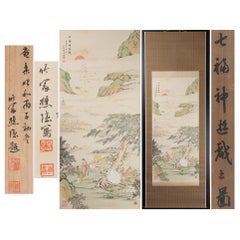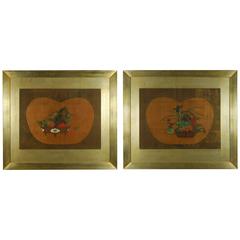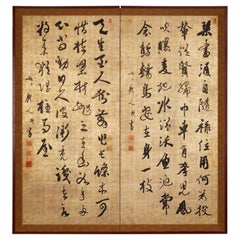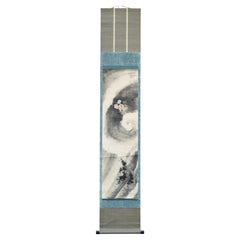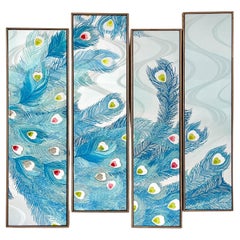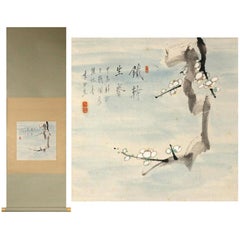Silk Paintings and Screens
to
94
310
106
504
34
1
8
4
2
1
45
213
246
35
115
46
16
11
3
18
7
3
10
8
3
773
759
722
539
492
519
504
425
53
16
539
521
526
30
2
1
1
1
Material: Silk
Immortals Nihonga Scene Meiji/Taisho Period Scroll Japan Artist Meiji Period
Located in Amsterdam, Noord Holland
Axis: Vertical 194 cm, Horizontal 49.5 cm
Inside: Vertical 126 cm, Horizontal 37 cm *Some errors will occur in the dimensions. Please understand.
Status I don't know the details of...
Category
20th Century Japanese Meiji Silk Paintings and Screens
Materials
Silk
$814 Sale Price
20% Off
Pair of Antique Japanese Flower Paintings by Yanagisawa Kien, circa 18th Century
By Yanagisawa Kien
Located in Prahran, Victoria
Pair of antique Japanese Nagasaki School paintings by Yanagisawa Kien (1704-1758), depicting classical ikebana flower arrangements. Each painted on silk in mineral pigments and beari...
Category
Mid-18th Century Japanese Edo Antique Silk Paintings and Screens
Materials
Silk
Japanese Two Panel Screen: Ink Calligraphy Poem of the Moon
Located in Hudson, NY
Poems refer to moon gazers. Ink on mulberry paper with a silk brocade border. Seals read: Roku-roku sai.
Category
19th Century Japanese Antique Silk Paintings and Screens
Materials
Brocade, Silk, Paper
Japanese Meiji Period Painting Scroll Water Spirit Japan Artist Signed
Located in Amsterdam, Noord Holland
Japanse school Watergeest
Rolschildering / scroll op papier, lakwerk rollers. B- 112 x 31.2 / 194 x 35.3 cm
112 x 31.2 / 194 x 35.3 cm
Category
Mid-19th Century Japanese Meiji Antique Silk Paintings and Screens
Materials
Silk
$1,198 Sale Price
20% Off
Antique kimono textile art " Peacock Feathers ~Royalty~ " by ikasu Blue , Japan
By Kimono ikasu
Located in Setagaya City, JP
This work uses an antique furisode (festive kind of kimono with long sleeves) with peacock feathers - a symbol of royalty and prosperity. Can be used both vertically and horizontally...
Category
Early 20th Century Japanese Japonisme Silk Paintings and Screens
Materials
Gold Leaf, Silver Leaf
Lovely Nihonga Scene Showa Period Scroll Japan Artist Fujimoto Kida
Located in Amsterdam, Noord Holland
It is a work produced by Fujimoto Kida as you can see.
It is composed of a calm and cool texture,
and combined with the sanction on the top, it is a very tasty work.
"Fujimoto K...
Category
Mid-20th Century Japanese Showa Silk Paintings and Screens
Materials
Silk
$814 Sale Price
20% Off
Landscape Flower Bird Scene Taisho Period Scroll Japan Artist
Located in Amsterdam, Noord Holland
Hanging scroll "Wakamatsu" Kinumoto coloring inscription box
Size Axis · · · 208.5cm in height 49.5cm in width
Drawing · · · 123cm in height 36cm in width.
Category
20th Century Japanese Taisho Silk Paintings and Screens
Materials
Silk
$1,198 Sale Price
20% Off
Immortals Nihonga Scene Meiji/Taisho Period Scroll Japan Artist Meiji Period
Located in Amsterdam, Noord Holland
Axis: Vertical 186 cm, Horizontal 47 cm
Inside: Vertical 107 cm, Horizontal 35 cm *Some errors will occur in the dimensions. Please understand.
Status I don't know the details of t...
Category
19th Century Japanese Meiji Antique Silk Paintings and Screens
Materials
Silk
$814 Sale Price
20% Off
Artists Miyao Jujin, Showa Period Bird and Plum Scroll Japan 20c Artist Nihonga
Located in Amsterdam, Noord Holland
As you can see, Hisato Miyao, Okayama Prefecture, wrote "Shiraume" plum and warbler, and comes with a box.
It is a plum and warbler figure expressed in a truly wonderful color, and...
Category
20th Century Japanese Showa Silk Paintings and Screens
Materials
Silk
$747 Sale Price
20% Off
Chinese Silk Woven Panel
Located in Lyndhurst, NJ
The silk woven panel depicting a scene of figures in and around a courtyard. The central panel having a separate woven border and all mounted in a giltwood...
Category
Late 19th Century Antique Silk Paintings and Screens
Materials
Silk
$1,600
Lovely Nihonga Scene Edo Period Scroll Japan Artist Yusen Okajima Japan
Located in Amsterdam, Noord Holland
It
is a work drawn by Yusen Okajima known as a Japanese painter of the Shijo school as you can see.
It is a waterfall map that makes you feel momentum from the top to the bottom, a...
Category
Early 19th Century Japanese Edo Antique Silk Paintings and Screens
Materials
Silk
$1,006 Sale Price
20% Off
Autumn landscape 20th Century Scroll Painting Japan Artist Kawagoe Tamado
Located in Amsterdam, Noord Holland
It is a high-class craft of the work drawn by Kawagoe Tamado as you can see.
It is the "late autumn in the highlands" where you can feel the taste of autumn, and it is
a work in which the trees and flowers that sway in the wind shine well.
«Kawagoedado»
[1873-1957] Japanese painter. Born in Aichi.
His real name is Hosaburo. Another issue, Ikuan.
At the beginning, he studied under the Shijo school and then Masakuni Hashimoto to...
Category
Early 20th Century Japanese Taisho Silk Paintings and Screens
Materials
Silk
$2,060 Sale Price
20% Off
Lovely Nihonga Scene Meiji/Edo Period Scroll Japan Artist Furuichi Kintome
Located in Amsterdam, Noord Holland
It is a work drawn by Furuichi Kintomi as you can see.
In addition to the fantastic depth of willow under the moon, the Egret
that shines in the night view is a truly delicious pie...
Category
19th Century Japanese Meiji Antique Silk Paintings and Screens
Materials
Silk
$814 Sale Price
20% Off
Lovely 20th Horii Ko Scroll Painting Japan Artist Flowers Painted
Located in Amsterdam, Noord Holland
Horii Ko?
1897 to 1990
Kyoto people
real name: Kiyotaro Horii
issue: Ko?
nurses: Kikuchi Chigiritsuki
Kyoto School of Arts & Crafts, Kyoto painting...
Category
Mid-20th Century Japanese Showa Silk Paintings and Screens
Materials
Silk
$1,581 Sale Price
20% Off
Japanese Meiji Period Painting Scroll Landscape Masuda Amison 1886 in Osaka
Located in Amsterdam, Noord Holland
Masuda Amison
(1886- ? ) Japanese painter. Commonly known as Wasaburo
Born in 1886 in Osaka.
He lives in Koroen, Nishinomiya City, Hyogo Prefecture....
Category
Early 20th Century Japanese Meiji Silk Paintings and Screens
Materials
Silk
$1,485 Sale Price
20% Off
Meiji Chrysanthemum Masterpiece
Located in Fukuoka, JP
Step into a world of timeless beauty with our exceptional six-panel screen from the Edo-Meiji period. In impeccable condition, each panel features stunning paintings of chrysanthemum...
Category
19th Century Japanese Meiji Antique Silk Paintings and Screens
Materials
Gold
Japanese Painting Scroll Crane Landscape Nihonga Japan Artist Sign
Located in Amsterdam, Noord Holland
Japanse school Vrouw op brug
Rolschildering / scroll op zijde, benen rollers. B 77.5 x 36.9 / 160 x 49 cm
77.5 x 36.9 / 160 x 49 cm.
Category
Mid-19th Century Japanese Meiji Antique Silk Paintings and Screens
Materials
Silk
$1,485 Sale Price
20% Off
Lovely Late Edo Period Scroll Paintings Japan Artist Landscape Painted
Located in Amsterdam, Noord Holland
Artist: "Hineno Taiyama"
End of the Edo period painter. Osaka production.
Hine Taizan (Hine Taizan, 10 years of culture (1813)-March 13, 1868 (April 24, 1869) is a literary painter...
Category
19th Century Japanese Edo Antique Silk Paintings and Screens
Materials
Silk
$1,102 Sale Price
20% Off
Scroll Kitsuda Eihô (1902 - 1974) Breaking of Dawn in the Mountains Japanese
Located in Amsterdam, Noord Holland
Kitsuda Eihô (1902 - 1974) Aanbreken van de dag in de bergen
Rolschildering / scroll op zijde, houten rollers, in houten cassette. Herkomst: Oranda Jin. B 128 x 41.9 / 202 x 56.3 cm...
Category
Mid-20th Century Japanese Meiji Silk Paintings and Screens
Materials
Silk
$1,581 Sale Price
20% Off
Farming Rice Fields Scene Meiji Period Scroll Japan 19c Artist Marked
Located in Amsterdam, Noord Holland
The simple country side life is the ideal of the Oriental scholar.
As you can see, the Kishi Renzan agricultural rice field working painting / box is included.
Agricultural rice fields are worked using horses...
Category
Mid-19th Century Japanese Meiji Antique Silk Paintings and Screens
Materials
Silk
$1,198 Sale Price
20% Off
Lovely 20th Araki Jippo Scroll Paintings Japan Artist Bird and Tree Painted
Located in Amsterdam, Noord Holland
"Araki jippo"
Japan painter.
Nagasaki prefecture production. First issue is Kinko. Name Teijiro.
Tokyo to study under Kanpo Araki, later it will be the Yoshishi.
You good at flow...
Category
Early 20th Century Japanese Edo Silk Paintings and Screens
Materials
Silk
$1,102 Sale Price
20% Off
Large Antique Japanese Scroll Depicting a Nesting Crane, Taisho Period
Located in Prahran, Victoria
Large and exceptional Japanese hanging scroll with a realistically painted depiction of a nesting crane by Yoshifuji Yoshio, Taisho/Showa perio...
Category
Early 20th Century Japanese Taisho Silk Paintings and Screens
Materials
Paper, Silk
Lovely 19th Tamazusa Kawabata Scroll Paintings Japan Artist Crane Painted
Located in Amsterdam, Noord Holland
Tamazusa Kawabata
1842-1913
Japan painter. Kyoto student. His name is Takinosuke, Keitei in another issue, and Kei in his later years. At the age of eleven, he entered the gate of Aki Nakajima, and later learned from Kaikei Oda. After moving to Tokyo, he learned oil painting with Yuichi Takahashi and Wargman. In addition, he became a modern Japanese Maruyama sect who loves Maruyama Okyo...
Category
19th Century Japanese Showa Antique Silk Paintings and Screens
Materials
Silk
$3,019 Sale Price
20% Off
Lovely 20th Yūki Somei Scroll Paintings Japan Artist Bird and tree Painted
Located in Amsterdam, Noord Holland
"Somei Yuki"
1875 (1875) - 1957 (1957)
Tokyo living, Japan painter.
Real name Sadamatsu, maiden name Morita.
Tamazusa Kawabata disciple, Tokyo art school graduation.
Empire Art ...
Category
Early 20th Century Japanese Edo Silk Paintings and Screens
Materials
Silk
$1,102 Sale Price
20% Off
Nightingale on Branch Meiji Period Scroll Japan 19/20c
Located in Amsterdam, Noord Holland
Very Lovely painting.
Category
Mid-19th Century Japanese Meiji Antique Silk Paintings and Screens
Materials
Silk
$1,198 Sale Price
20% Off
Japanese Silk Suijaku Scroll Nyorai-Kojin with Mixed Buddhism and Shinto Deities
Located in Atlanta, GA
A Japanese silk Suijaku hanging scroll beautifully presented in a custom wood shadow box frame from Edo period (circa 18-19th century). The scroll, surmounted on golden brocade was painted in fine details with gouache, ink and gold powder highlight, served as a Suijaku mandala for the worshippers. Honji Suijaku is a complicated religious concept uniquely developed in Japan. It mixed and hybrid the Buddism deities with native shinto spirits (known as Kami), which were seen as local manifestations (the suijaku, literally means a "trace") of Buddhist deities (the honji literally the original ground). The original idea may lie with the synergetic strategy to spread Buddism by making it more relatable to the local population who had already worshiped Shinto gods. The paradigm, adopted in the 10th century from an orignal Chinese concept, remained a defining feature of Japanese religious life up to the end of the Edo period (1868). Instead of being confined to deities, its application was often extended to historical figures as shown on this scroll.
This long hanging scroll depicts an arrangement of 21 figures including Buddhism and Shinto deities as well as two historical figures on the bottom. Each figure was name-tagged in Kanji for easy identification by the worshippers. It was used in the temple or shrine so that when the worshipper prayed in front the mandala, they prayed simultaneously to all the deities.
On the very top, sits Nyorai-Kojin, a hybrid deity of Nyorai Buddha and Kojin, the kaki for fire, stove and kitchen. From the top to bottom and left to right, here is the list of the deities: Kanon with Thousand Hands, Kanon with Willow Branch, Monju Bosatsu...
Category
Early 19th Century Japanese Edo Antique Silk Paintings and Screens
Materials
Silk, Wood
Japanese Six Panel Screen: Black and Gold Lacquer Flower Festival Cart
Located in Hudson, NY
Abundant flower arrangement of peonies in a basket, with a four legged rest to the right and a twig fence to the left. Fine lacquer ceremonial cart with silk ties and areas of raised...
Category
Early 19th Century Japanese Antique Silk Paintings and Screens
Materials
Gold Leaf
Lovely 20th Century Tatehiko Kan Scroll Paintings Japan Artist Crane Painted
Located in Amsterdam, Noord Holland
Tatehiko Kan
1878-1968
Tottori Prefecture born
real name: FujiTaro Sugawara
issue: Moritora, Shizuko, Tatehiko
Japan Art Academy Imperial Award, Osaka Art Association member, Os...
Category
19th Century Japanese Showa Antique Silk Paintings and Screens
Materials
Silk
$3,019 Sale Price
20% Off
Artists Suiho Yano Showa Period Scroll Japan 20c Artist Nihonga
Located in Amsterdam, Noord Holland
As you can see, it is a work of "Basho / Sparrow" drawn by Midori Yano.
Under Basho, this work skillfully depicts the appearance of sparrows forming a flock and singing food.
«Su...
Category
20th Century Japanese Taisho Silk Paintings and Screens
Materials
Silk
$1,140 Sale Price
20% Off
Lake Awasaru Scene Meiji Period Scroll Japan 19c Artist Marked Nihonga Style
Located in Amsterdam, Noord Holland
As you can see, it is a Japanese painting "Lake Suwa Asaharu" figure / co-box.
It is a "Lake Suwa Asaharu" figure with gentle sunlight, and it is
a very tasty work combined with a ...
Category
Mid-19th Century Japanese Meiji Antique Silk Paintings and Screens
Materials
Silk
$1,198 Sale Price
20% Off
Japanese Two-Panel Screen, Harbor Scene in a Modernist View
Located in Hudson, NY
Bountiful mountain overlooking a city, divided by an occupied river. The shapes and colors that make up this unique painting allow for an unconventional take on a modern harbor view....
Category
Early 20th Century Japanese Silk Paintings and Screens
Materials
Gold, Brass
Lovely Scroll Paintings Japan Artist Signed Wakasa Seigyo Monogai "Spring Breeze
Located in Amsterdam, Noord Holland
Wakasa Seigyo "spring breeze garden view", silk, colors, painting, hanging scroll, with box
Size: Axis, vertical 142 cm horizontal 65.5 cm
picture, vertical 44 cm horizontal 50.5...
Category
20th Century Japanese Showa Silk Paintings and Screens
Materials
Silk
$1,033 Sale Price
25% Off
Hanging scroll : red camellia and birds
Located in Fukuoka, JP
Showa Period Japanese Hanging Scroll – Birds and Blossoming Flowers
This exquisite Japanese kakejiku (hanging scroll) from the Showa period (1926–1989) is meticulously hand-painted ...
Category
20th Century Japanese Silk Paintings and Screens
Materials
Silk, Wood, Paper
Large Antique Zen Japanese Ink Scroll After Sesson Shukei
Located in Atlanta, GA
A Japanese Sumi ink painting with light color wash mounted with brocade borders as a hanging scroll (Kakejiku). The painting depicts the famously eccentric Buddhist monks Hanshan and Shide (known in Japan as Kanzan and Jittoku). Often as a pair, they have been a popular motif in Japanese Zen painting...
Category
18th Century Japanese Japonisme Antique Silk Paintings and Screens
Materials
Silk, Paper
Vintage obi textile art " Camellia ~ Serendipity ~ " by ikasu Blue, Japan
By Kimono ikasu
Located in Setagaya City, JP
This work is inspired by traditional Japanese nature motifs symbolism, and is framed in paulownia wood originally used for a kimono chest-of-drawers.
In this artwork, the aim was to capture the the auspicious symbol of camellia used in antique kimono. Traditional Japanese culture, represented by the kimono, and wood, an integral element of Japanese craftsmanship, were used to bring this vision to life.
I used pieces of kimono that could no longer be used as clothing and kiritansu chest-of-drawers that would normally be discarded to create the ultimate upcycled piece.
<< Explanation and meaning of pattern and colors >>
This delicate piece features hand-drawn camellia motifs flowing gracefully on a softly brightened grayish background.
Camellias, native to Japan, bloom from winter to early spring. As an evergreen tree with green leaves throughout the year, it symbolizes the anticipation of spring and is considered an auspicious plant. Due to its seasonal significance and auspicious meanings, camellias have been used as motifs symbolizing good fortune. Additionally, they were highly valued for their use in oil, cosmetics, and medicine, representing nobility. Believed to possess the power to ward off misfortune, camellias also carry the meaning of "protection from calamity" and have strong ties to traditional ceremonies. In this artwork, camellias are delicately depicted alongside flowing branches, subtly representing good fortune with their pale pink and white hues.
"Sora-iro nezumi 空色鼠" refers to a light grayish color with a hint of blue, reminiscent of the slightly brightened sky on a lightly cloudy day. Popular during the late Edo period (19th cent.), it elegantly captures the slightly brighter sky pattern seen on lightly overcast days. Notably, the term "nezumi-iro" (mouse gray), popular during the late Edo period, was paired with brown tones, collectively known as "Forty-eight Teas and a Hundred Mice 四十八茶百鼠." Colors within the "nezumi" (gray) spectrum, particularly "sora-iro nezumi," were favored by young people for their cool and sophisticated appeal.
<< Characteristics of the fabric >>
The fabric features intricately woven patterns that reveal subtle gradations through dyeing, creating a grid pattern that transforms depending on the light conditions.
Originally, this fabric was part of a formal kimono known as a "hōmongi 訪問着," featuring motifs along the hem, shoulders, and sleeves. These motifs have been carefully selected and combined to create a unified piece of artwork.
<< About the frame >>
Kiritansu - chest-of-drawers for kimono, is traditionally made from paulownia wood, a uniquely Japanese material closely tied to the world of kimonos.
Paulownia wood is known as the lightest wood in Japan, prased for its natural luster, resistance to moisture, and resilience against cracking. Since ancient times, it has been used in crafting furniture, chests, and musical instruments.
During the Edo period, it became customary to store cherished kimonos in paulownia chests...
Category
1960s Japanese Japonisme Vintage Silk Paintings and Screens
Materials
Silk, Wood
Japanese Two-Panel Screen Chinese Style Painting with Calligraphy
Located in Hudson, NY
Painting of a perforated garden stone with red bamboo growing behind. Chinese zekku poem reads, "Returning home to my grass hut on a spring evening," by the Tang-poet Qian Qi. Screen...
Category
Early 20th Century Japanese Taisho Silk Paintings and Screens
Materials
Silk, Paper, Wood
Japanese Two Panel Screen, Zen Calligraphy Character Cloud
Located in Hudson, NY
Meiji period (1868 - 1912) calligraphy painting. Abstract character reads: Kumo (cloud). Seal on the upper right reads Shogazen, seal on the upper left reads Hosai. Ink on mulberr...
Category
Early 20th Century Japanese Meiji Silk Paintings and Screens
Materials
Silk, Wood, Paper
Japanese Two Panel Screen: Kanzan and Jittoku
Located in Hudson, NY
Prominent figures in Japanese folklore. The Chinese poet-sage Kanzan is depicted with his scroll, and the Daoist sage Jittoku with his broom. Painting bears two seals of Nakanuma Sho...
Category
Late 19th Century Japanese Antique Silk Paintings and Screens
Materials
Gold
Vintage obi textile art "Broken Vase ~kintsugi~" by ikasu Black / Gold, Japan
By Kimono ikasu
Located in Setagaya City, JP
This textile artwork uses a vintage obi dated around 1980ies, with a feather motif, and arranges it so that it looks like a vase.
Antique obi, just as it is a broken vase, is united back again with black obijime - a string used to tie up obi when it’s worn. Framed in kiritansu (antique chest) paulownia wood.
It is elegantly framed with paulownia wood originally used for kimono chest-of-drawers, and is filled with storytelling and sense of luxury.
I used pieces of kimono that could no longer be used as clothing and kiritansu chest-of-drawers that would normally be discarded to create the ultimate upcycled piece.
<< Explanation and meaning of pattern and colors>>
Feathers hold various meanings and symbolism in Japanese traditional culture, often reflecting themes of spirituality, symbolism, and folklore. Here are some of the meanings associated with feathers in Japanese tradition:
・Divine Protection: Feathers are often seen as symbols of divine protection and spiritual guidance. Feathers, especially those from birds, are considered to be imbued with the protective energy, offering spiritual guardianship and safeguarding against negative forces.
・Connection to the Spirit World: Feathers are sometimes associated with the spirit world and the realm of the divine. In folklore and mythology, feathers are depicted as messengers between the earthly realm and the celestial realms.
・Symbol of Beauty and Elegance: Feathers are admired for their natural beauty, grace, and elegance. In traditional Japanese arts such as Noh theater, Kabuki, and dance performances like Kagura, actors and performers often use feathered costumes or accessories to enhance their appearance and convey a sense of refinement and sophistication.
・Sign of Good Luck and Prosperity: In Japanese folklore, certain birds like cranes and pheasants are considered symbols of good fortune, longevity, and prosperity. Feathers from these birds are often depicted in art and craftwork as auspicious symbols believed to bring blessings and positive energy to the bearer.
<>
Kiritansu - chest-of-drawers for kimono, is traditionally made from paulownia wood, a uniquely Japanese material closely tied to the world of kimonos.
Paulownia wood is known as the lightest wood in Japan, prased for its natural luster, resistance to moisture, and resilience against cracking. Since ancient times, it has been used in crafting furniture, chests, and musical instruments.
During the Edo period, it became customary to store cherished kimonos in paulownia chests...
Category
1980s Japanese Japonisme Vintage Silk Paintings and Screens
Materials
Silk, Wood
Framed Painting on Silk, Harbor at Night By: Chiga Saku
Located in Hudson, NY
Pigments on silk. Signature and seal read: Chiga saku (Acid free mounting with UV plexiglass) Painting dimentions: 59" H x 34" W, overall dimentions: 63 1/4" H x 38 1/2" W.
Category
Early 20th Century Japanese Silk Paintings and Screens
Materials
Silk
Japanese Silk Scroll of Daruma Hanabusa Itcho Edo Period
Located in Atlanta, GA
A Japanese hanging scroll attributed to Edo period painter Hanabusa Itcho (1652-1724). The artwork features a silk roundel nicely mounted in golden brocade background. The painting depicts a robed Daruma seated in meditation with his eyes widely open. The rendition of the famous monk, one of the most beloved subjects in Japanese art, was extremely minimalistic. With just a few effective ink strokes and patches of watercolor, it managed to successfully highlight the essence and spirit of Daruma. The roundel was possibly a center fragment of a larger painting by the artist and was remounted historically. Signed with one of his artist's names. It comes with a wood scroll box with ink inscription of title and artist formal name.
For a painting with the same signature, see number 1881,1210,0.1719 in the collection of the British Musuem. Also a horizontal scroll...
Category
18th Century Japanese Edo Antique Silk Paintings and Screens
Materials
Silk, Paper
Japanese Four Panel Screen: Japanese Tree Sparrows on Stacks of Bailed Rice
Located in Hudson, NY
Sparrows ravish freshly harvested rice, drying on stakes, beyond wild chrysanthemum. Mineral pigments on silk. Signed in the lower left corner, signature reads: Soetsu. With a simple...
Category
Early 20th Century Japanese Silk Paintings and Screens
Materials
Silk, Wood, Lacquer
Antique Japanese Hanging Scroll Attributed to Iwasa Matabei
Located in Atlanta, GA
An antique ink and color on paper hanging scroll (kakejiku) with brocade border. It appears to be a fragment of a larger hand scroll depicting a procession of a lord with his entoura...
Category
Early 17th Century Japanese Japonisme Antique Silk Paintings and Screens
Materials
Silk, Paper
Chinese Ink and Colour on Fabric Painting, "Emperor"
Located in West Palm Beach, FL
Chinese ink and colour on fabric
Painting,
"Emperor"
Qing Dynasty, set within two lucite panels
Measures: The painting 87 by 151 cm., 34.5 by 59.5 in.,
Please note that this l...
Category
20th Century Silk Paintings and Screens
Materials
Silk
19th Century Japanese Scroll of Hollyhocks
Located in Hudson, NY
Seal on lower right reads: I'nen. Beautiful and delicate Rimpa painting using tarashikomi (painting-in) technique of wet on wet painting. Painted in a style reminiscent of the famous...
Category
19th Century Japanese Antique Silk Paintings and Screens
Materials
Silk, Wood, Paper
Japanese Two Panel Screen: Mountain Landscape with Calligraphy
Located in Hudson, NY
Japanese Two Panel Screen: Mountain Landscape with Calligraphy. Late Edo (c. 1850) painting of a dramatic mountainside carved by a waterfall with a crane flying in the foreground an...
Category
Mid-19th Century Japanese Edo Antique Silk Paintings and Screens
Materials
Silk, Wood, Paper
Vintage obi textile art "Under the Sun ~Serendipity " by ikasu Red / Beige Japan
By Kimono ikasu
Located in Setagaya City, JP
This artwork creatively uses tree bark to evoke the imagery of woods and mountains during both the morning and nighttime on left and right. It is elegantly framed with paulownia wood, a tree closely connected to kimono culture, and is filled with storytelling and sense of luxury.
By incorporating both the front and back sides of the same obi fabric woven in different colors, the play of light and shadow on the mountains is depicted through the contrasting appearances of these surfaces.
The intention behind this piece is to convey the exquisite beauty of Japanese mountains and the lush forests that inhabit them. To achieve this, traditional elements of Japanese culture, such as obi textiles and craftsmanship involving wood, were used.
The outer side and inner linings of the same obi, no longer suitable for clothing, along with bark material that would normally be discarded, have been repurposed to create this exceptional upcycle artwork.
The fusion of Japanese natural materials – silk, paulownia wood, and pine bark for the central decoration – along with the so-called "Tozan" pattern, a unique Japanese natural design showing mountains from far-away point, captures the magnificent beauty of Japanese nature from various perspectives.
The central bark decoration stands out as a distinctive feature of this work. Pine, oak, and other tree barks are interwoven among the mountains woven into the obi, creating a tangible and authentic natural atmosphere.
<< Period / Story >>
The obi used in this piece was originally crafted during the late Showa period (1960-80ies).
<< Explanation and meaning of pattern and colors >>
This upcycle artwork uses an obi with a tozan pattern woven in two colors. The design is inspired by a distant mountain range, a motif that has been used in paintings and crafts since ancient times. However, in this particular design, the mountains are depicted not as distant peaks but as graceful semicircles giving it a mild atmosphere.
<< Characteristics of the fabric >>
This upcycled Fukuro-obi (two-side obi) showcases a festive color pattern of mountains intricately woven with gold threads against a beige front and red on the back.
The way this obi interacts with light allows it to shift in expression, much like a mountain revealing different facets over time. It can transform from deep shades of color to the appearance of gold shimmering against bright hues, depending on the lighting and viewing angle.
<< About the frame >>
Kiritansu - chest-of-drawers for kimono, is traditionally made from paulownia wood, a uniquely Japanese material closely tied to the world of kimonos.
Paulownia wood is known as the lightest wood in Japan, prased for its natural luster, resistance to moisture, and resilience against cracking. Since ancient times, it has been used in crafting furniture, chests, and musical instruments.
During the Edo period, it became customary to store cherished kimonos in paulownia chests...
Category
Late 20th Century Japanese Japonisme Silk Paintings and Screens
Materials
Silk, Wood
Early 19th Century Japanese Scroll Bijin after the Bath in Summer
Located in Hudson, NY
Early 19th century Japanese Scroll: Bijin after the bath in summer. Painted in pigments on silk. Signature reads: Yamauchi Sentsu.
Japan,...
Category
Early 19th Century Japanese Edo Antique Silk Paintings and Screens
Materials
Silk, Wood
Japanese Two Panel Screen: Hawk Perched in Pine Tree
Located in Hudson, NY
Hawks were a popular motif in artwork because Japanese falconry, or takagari, was a sport of aristocrats such as nobles and samurai. Hawks came to symbolize nobility and strength. Su...
Category
17th Century Japanese Antique Silk Paintings and Screens
Materials
Brocade, Silk, Paper
Japanese Antiques 4th Head Torii Kiyotada Silk Painted Scroll, Festival, Sword
Located in Niiza, JP
Torii School Head 7th Generation [4th Generation Torii Kiyotada] Silk Painted Scroll, Festival, Sword, May
Silk Painted
Scroll head: Ceramic
box: Paulownia wood
Size: Painting size: 330 (W) x 1130 (H) [mm]
Scroll: 360 (W) x 2000 (H) [mm]
Box size: 70 x 70 x 435 mm, 600g
A large composition depicting a Japanese sword
It is thought to represent the May festival
Sekku (seasonal festival) means a day that is a turning point in the season, or a traditional event that is held on that day.
Held in May, old weapons...
Category
19th Century Japanese Antique Silk Paintings and Screens
Materials
Silk, Paper
Japanese Two Panel Screen: Dancing Zodiac Animals at New Years Festival
Located in Hudson, NY
Animals of the Japanese zodiac dancing in colorful costumes celebrating the New Year.
Category
Early 19th Century Japanese Antique Silk Paintings and Screens
Materials
Brocade, Silk, Paper
Japanese Two Panel Screen: Sheep Resting under Grape Arbor
Located in Hudson, NY
Soft mineral pigments on silk with brocade border. Signature and seal read: Jyogyu
Category
Early 1900s Japanese Antique Silk Paintings and Screens
Materials
Brocade, Silk
Japanese Two-Panel Screen, Cockscomb and Morning Glories
Located in Hudson, NY
Nihonga style, finely painted spring flowers with a dragonfly detail in mineral pigments on silk. Signed and sealed: "Seichu". Real name: Aoki Keinosuke (1891-1973), born in Kyoto, s...
Category
Early 20th Century Japanese Silk Paintings and Screens
Materials
Cotton, Silk, Lacquer
Japanese Six Panel Screen Bulls in a Gentle Landscape
Located in Hudson, NY
Sumi (ink) painting of bulls next to a stream with minimal colors on mulberry paper with silk brocade border.
Category
19th Century Japanese Antique Silk Paintings and Screens
Materials
Silk, Paper
Japanese Two Panel Screen: A Boy and His Shiba Dog on Temple Grounds
Located in Hudson, NY
Artist: Katsumi Aizu, who won many awards at Inten Exhibition. Ink and mineral pigments on mulberry paper with a silk brocade border.
Category
Early 20th Century Japanese Silk Paintings and Screens
Materials
Brocade, Silk, Paper
Japanese Two-Panel Screen "Spring Mist in Kyoto"
Located in Hudson, NY
Kyoto landscape featuring Kyomizu Shrine in all its glory in the Higashiyama Hills.
Artist signature and seal read: Asami Kojo
Mineral pigments on mu...
Category
1950s Japanese Vintage Silk Paintings and Screens
Materials
Silk, Paper
Pair of Large Antique Japanese Paintings
Located in West Palm Beach, FL
A pair of large antique Japanese paintings of Cockerel and Hen with chicks among timber bamboo. Mounted in the single panel screen panel styl...
Category
1880s Antique Silk Paintings and Screens
Materials
Silk
Japanese Six Panel Screen: the Burning of Nanto Temple
Located in Hudson, NY
A scene from the 12th century Heike wars. Ruler Taira Shigehira ordered an attack on those who opposed his rule. During the battle, Nanto Temple, in Nara, was burned to the ground. T...
Category
19th Century Japanese Antique Silk Paintings and Screens
Materials
Gold, Bronze
Price Upon Request
Japanese Two Panel Screen: Flowering Lilies on the Beach with Dancing Crabs
Located in Hudson, NY
Japanese Two Panel Screen: Flowering Lilies on the Beach with Dancing Crabs.
Taisho (1912-1926) period painting of spider lilies, tiger lilies, and morning glories in bloom at the ...
Category
Early 20th Century Japanese Taisho Silk Paintings and Screens
Materials
Wood, Silk
Recently Viewed
View AllMore Ways To Browse
Japanese Red Lacquer Frame
Lattice Panel Wood
Hanging Japanese Screen
Japanese Lattice
Japanese 19th Century Meiji Period Silk Painting
Japanese Buddhist Screen
Japanese Carved Screen
Japanese Screens And Doors
Monkey Screen
Japanese Autumn Screen
Japanese Screens Six Fold
Japanese Wood Room Divider
Kyoto Silk Painting
Japanese Dragon Painting
Japanese Birds Painted On Silk
Heian Period
Japanese Crane Panel
Japanese Divider Screen
